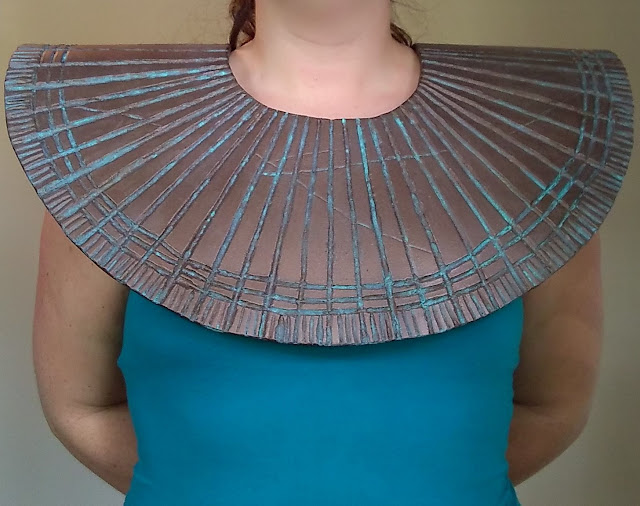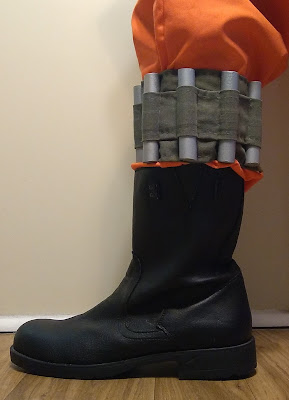How to make a post-apocalypse hardware necklace
A key part of living after the apocalypse is to use defunct objects for new purpose. I guess the fancy term is "upcycling" but whatever it's called it does tend to make sense. Without new parts being made and resources dwindling, it makes sense to hold onto the parts that endure, even if they can't be used as they were first intended. And after awhile the original purpose can be lost, only to be reincarnated in artwork, jewelry, and talismans. I always wanted to experiment with some of these ideas, and so I made a necklace using some old hardware.
This has probably been done to death, and there are plenty of much more inventive projects found on Pinterest or other parts of the internet (any searches including "industrial" "hardware" and "jewelry" will show you a mountain of projects). But for my post-apocalyptic build here's what I made.
Possible Materials
-Washers
-Hexnuts
-Crimp sleeves
-Other assorted hardware
-Found objects (old keys, coins, tire weight, scrap metal, etc.)
-Waxed cotton thread
-Paracord
Tools
-Scissors
1. Gather the materials
These materials can be found in hardware stores, craft stores, and left behind in parking lots and roadsides. The key is to find interesting metal objects, and there are plenty of those at any hardware store. For stringing material, I ultimately chose to use a waxed cotton cord, but paracord is another interesting option. I would add that you should be careful with any found objects, don't use anything that could be hazardous (lead, sharp edges, etc.). A little cleaning and sandpaper can help in some situations.
Although most of the "aged" parts were found on the side of the road, you can artificially accelerate these processes with newly bought hardware. Depending on the material and plating, there are several ways to help along or mimic rust, wear, and various patinas. If you look in the paint section of a craft store you can often find products that are useful for aging metal and recreating patina, and there are several tutorials online doing the same with steel wool, vinegar, bathroom cleaner, and other household items (though the methods will vary depending on the metal).
2. Design the necklace
Before putting the necklace together, it's very useful to experiment with the pieces.
Here are some examples of possible combinations:
3. Choose the cord length
I don't think there's a magic length to advise on, I'd just say cut way more than you think you'll need. I went for over 24 inches.
4. String the pieces
I'm not much of a knot-tier, but I started with a cow hitch threaded through the tire weight and the first washer to the middle of the cord. Here's the knot before it is pulled tight:
And here it is pulled tight:
I repeated this trick on attaching the two washers together.
And then I continued the hitch one step more to the top of the last washer:
I had these grand plans to make the necklace more complicated, but ultimately I decided on this simpler piece. If I were making a post-apocalypse character who was more of a gearhead, a shaman, or even a chief I would go for a more intricate design.
5. Finishing touches
To make the necklace adjustable, I tied the ends of cord to each other using sliding knots (aka fisherman's knots aka necklace slipknots). I did a very simple version of this, but you find much better instructions on these methods on other sites (a pretty good tutorial can be found here).
And there you have it, one of many projects you can do using old hardware and found objects. Here are some extra shots of getting way too into an odd shawl/cloak with the necklace. Maybe my post-apocalypse character is more of a leader in the wasteland than I had previously thought...
This has probably been done to death, and there are plenty of much more inventive projects found on Pinterest or other parts of the internet (any searches including "industrial" "hardware" and "jewelry" will show you a mountain of projects). But for my post-apocalyptic build here's what I made.
Possible Materials
-Washers
-Hexnuts
-Crimp sleeves
-Other assorted hardware
-Found objects (old keys, coins, tire weight, scrap metal, etc.)
-Waxed cotton thread
-Paracord
Tools
-Scissors
1. Gather the materials
These materials can be found in hardware stores, craft stores, and left behind in parking lots and roadsides. The key is to find interesting metal objects, and there are plenty of those at any hardware store. For stringing material, I ultimately chose to use a waxed cotton cord, but paracord is another interesting option. I would add that you should be careful with any found objects, don't use anything that could be hazardous (lead, sharp edges, etc.). A little cleaning and sandpaper can help in some situations.
Although most of the "aged" parts were found on the side of the road, you can artificially accelerate these processes with newly bought hardware. Depending on the material and plating, there are several ways to help along or mimic rust, wear, and various patinas. If you look in the paint section of a craft store you can often find products that are useful for aging metal and recreating patina, and there are several tutorials online doing the same with steel wool, vinegar, bathroom cleaner, and other household items (though the methods will vary depending on the metal).
2. Design the necklace
Before putting the necklace together, it's very useful to experiment with the pieces.
Here are some examples of possible combinations:
3. Choose the cord length
I don't think there's a magic length to advise on, I'd just say cut way more than you think you'll need. I went for over 24 inches.
4. String the pieces
I'm not much of a knot-tier, but I started with a cow hitch threaded through the tire weight and the first washer to the middle of the cord. Here's the knot before it is pulled tight:
And here it is pulled tight:
I repeated this trick on attaching the two washers together.
And then I continued the hitch one step more to the top of the last washer:
I had these grand plans to make the necklace more complicated, but ultimately I decided on this simpler piece. If I were making a post-apocalypse character who was more of a gearhead, a shaman, or even a chief I would go for a more intricate design.
5. Finishing touches
To make the necklace adjustable, I tied the ends of cord to each other using sliding knots (aka fisherman's knots aka necklace slipknots). I did a very simple version of this, but you find much better instructions on these methods on other sites (a pretty good tutorial can be found here).
















Comments
Post a Comment